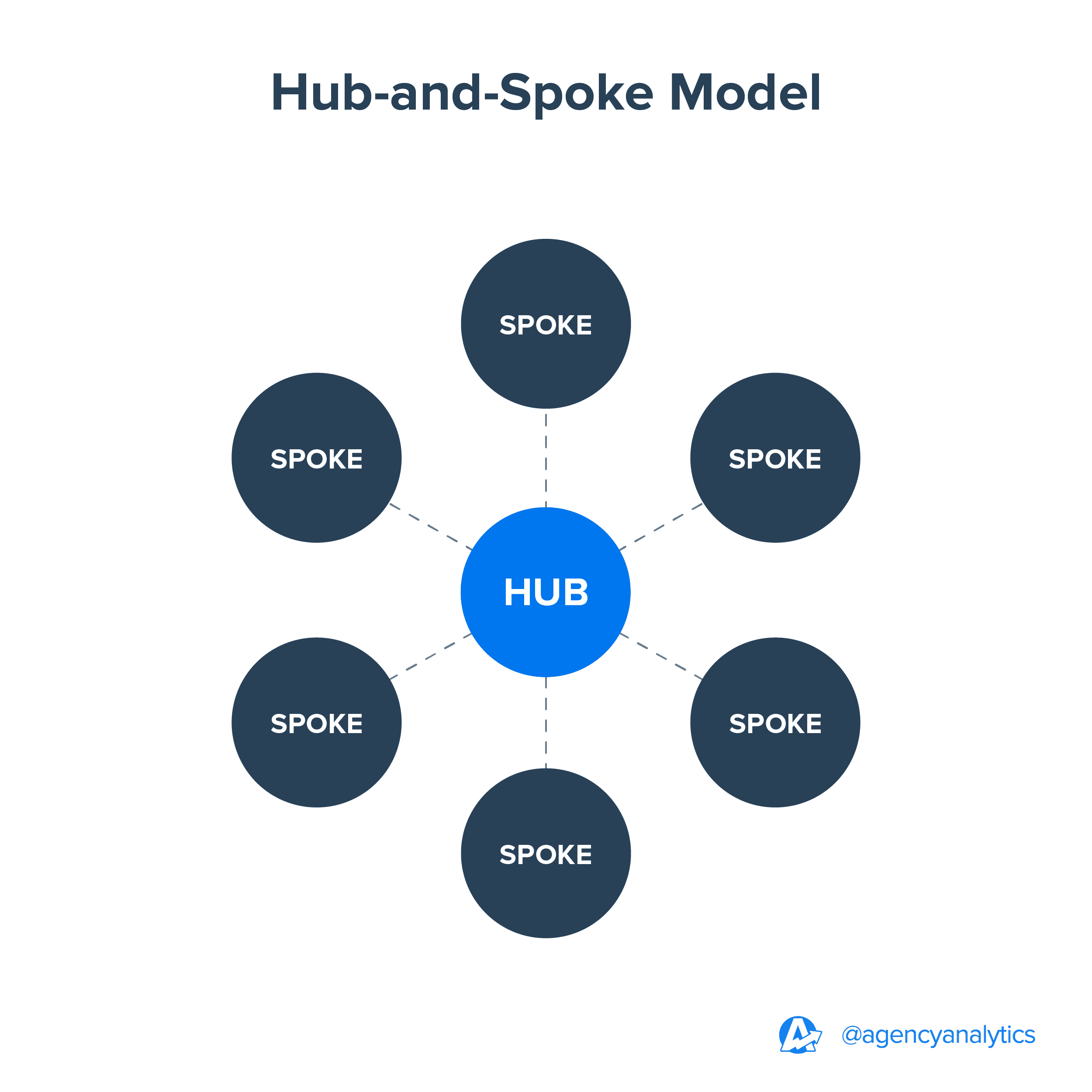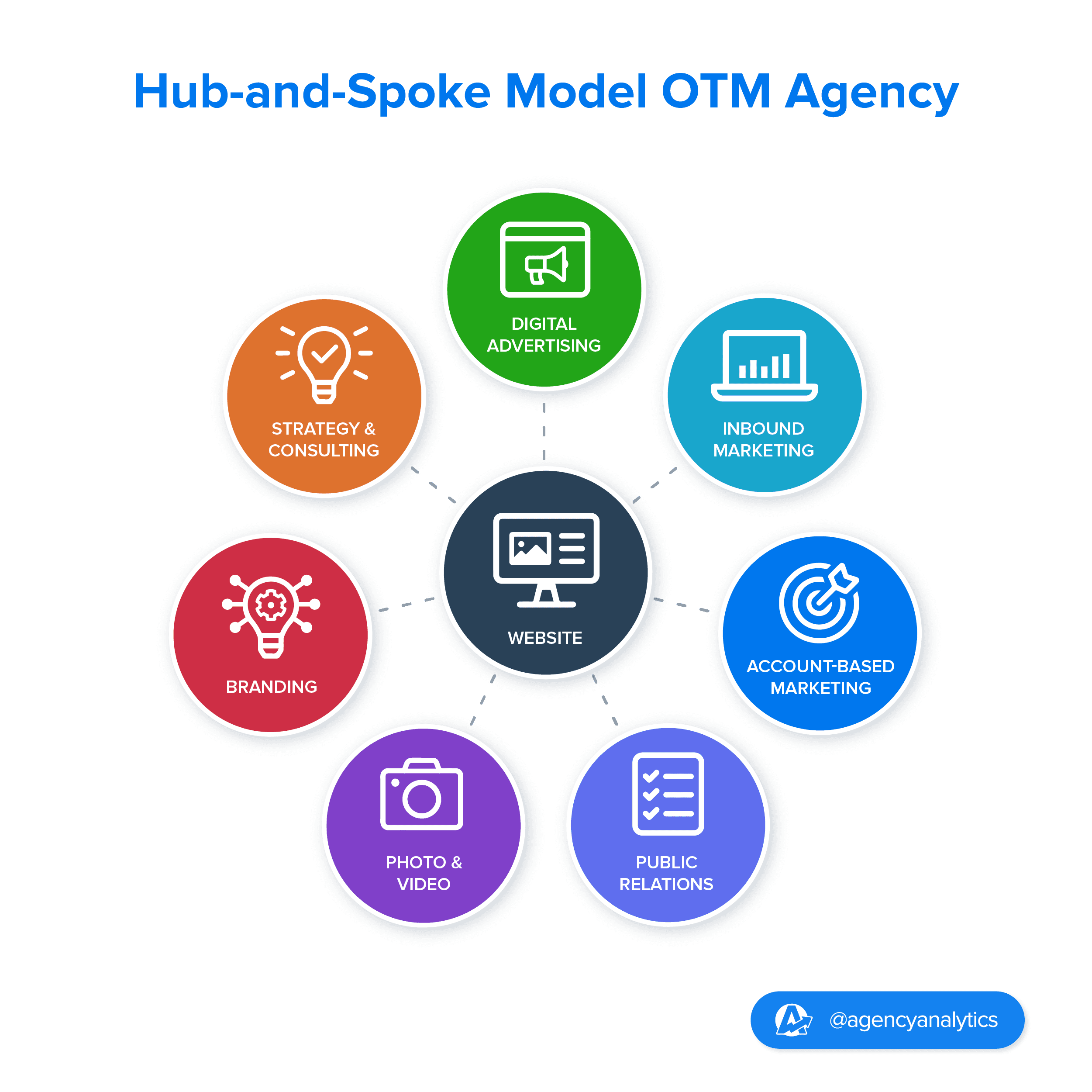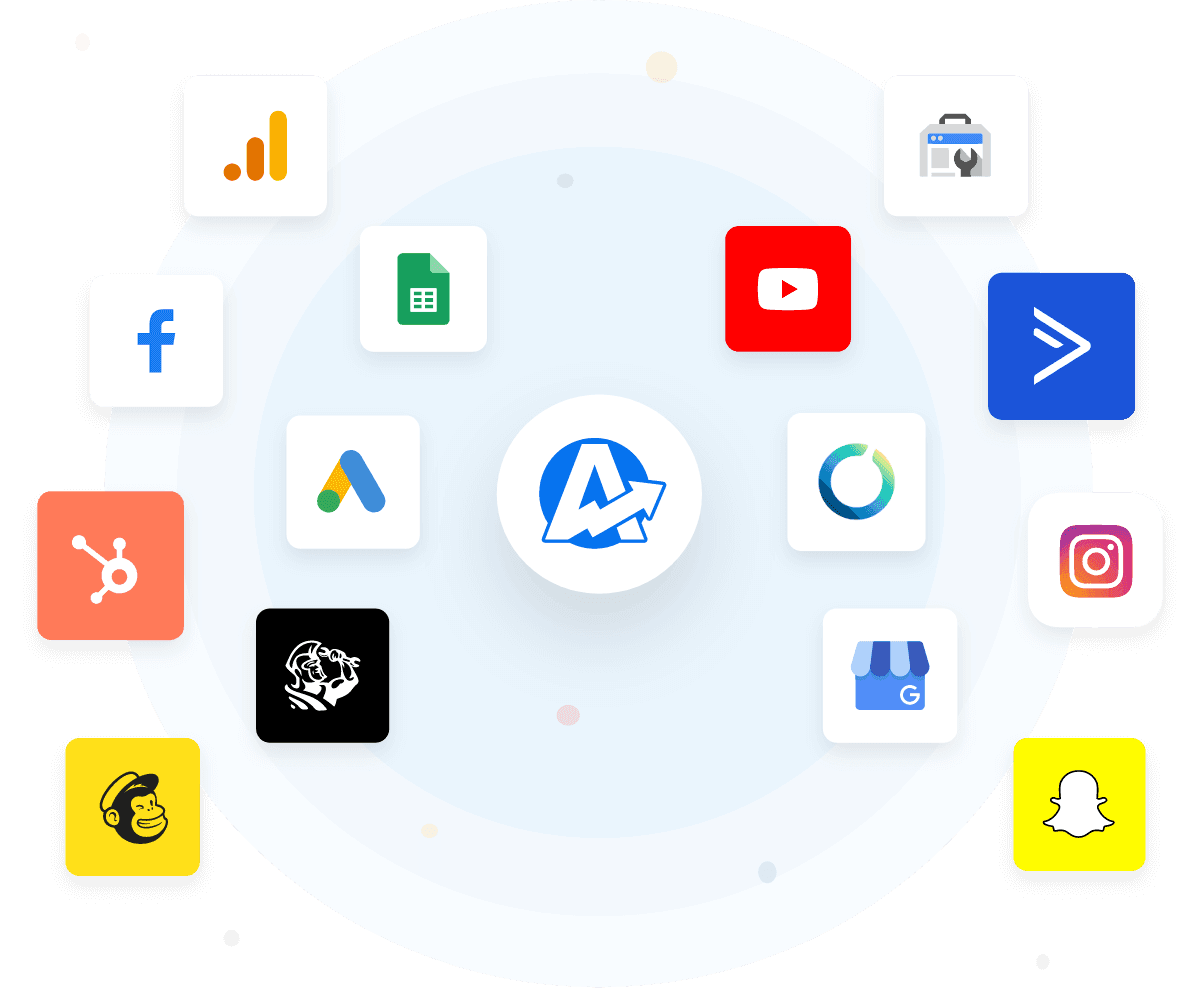Table of Contents
QUICK SUMMARY:
The hub-and-spoke model is a strategic framework that helps agencies scale by centralizing core services and extending complementary offerings. This approach streamlines operations, enhances service quality, and supports personalized marketing strategies. Agencies employing this model better manage client relationships and optimize service delivery, promoting growth and client satisfaction.
Like many digital agencies launched in the mid to late ’00s, Colorado’s OTM started in website design and development.
After acquiring a stable roster of clients and successfully scaling the agency, the market upheaval resulting from widespread adoption of self-serve web design services like Wix and Squarespace placed OTM at a sudden crossroads.
Agency leaders Miles and Vallene Kailburn decided to pivot and redesign OTM’s client services offering from strictly website design to a more comprehensive marketing strategy model that also included digital advertising, inbound marketing, account-based marketing, public relations, photo and video, branding, and strategy and consulting.
To do so, they hired a full-time marketing director, Kerrie Luginbill, and put her in charge of running these new services. At the same time, Miles and Vallene continued to run OTM’s core business service with its existing clients.
We just said, ‘We have this little machine running over here that cranks out a bunch of websites, and we'll just put your office over here, and we'll run them that way.’
Miles Kailburn, CEO & Co-Founder, OTM
This turned out to be a mistake, as they soon realized that they had created two disconnected business silos that didn’t interact with one another.
There was no cross-selling, there was no co-management. It took us three years to merge those silos together so we could have larger client value lifetime values and a singular point of contact.
Miles Kailburn, CEO & Co-Founder, OTM
It’s a situation many agency leaders face when they scale their operations and introduce new services:
How does the agency ensure their foundational services work in tandem with new offerings?
How do they capitalize on opportunities for upselling and cross-selling?
Perhaps most importantly, how do they avoid alienating existing clients while spurring buy-in for new (and perhaps less understood but indisputably valuable) channels and mediums?
Enter the hub-and-spoke model, which enables businesses like OTM to break away from silos by creating an interconnected services ecosystem that serves clients better and encourages collaboration and communication.
In this article, you’ll learn how the hub-and-spoke model works, how it helps agencies tie service offerings together, and how it ultimately helps agencies scale faster and more effectively. Plus, we'll give you a free hub-and-spoke template for your agency!
What Is the Hub-and-Spoke Model?
The hub-and-spoke model is a distribution system arranged like a bicycle wheel, where all traffic flows through a central hub or node before being distributed to various spokes.
At its simplest, the hub-and-spoke model is about centering your agency around a core offering—i.e., your "central hub." It’s what you’re best at, your agency’s bread and butter. Then, branching out from this hub are your "spokes," the complementary services that enhance and support your central service.

As clients’ needs increase and integrated marketing opportunities arise, the hub-and-spoke system offers a way to streamline your efforts without losing depth or quality. It encourages collaboration, reduces operational inefficiencies, and ensures every service you offer pulls in the same direction.
Using the Logistics Industry Blueprint for Agency Marketing
The hub-and-spoke model is widely used in supply chain logistics to optimize and streamline the distribution of goods, improve delivery efficiency, and reduce transportation costs. It’s also a great example to illustrate an optimized structure of services offered by digital marketing agencies.
Here's how the hub system works in both contexts and how they parallel each other:
In Logistics
Distribution Hub: The central point where goods are collected, sorted, or redistributed to other destinations.
For example, a major airport or a central warehouse acts as the hub of logistics networks. Central hubs direct core operations, making it easier to manage resources and optimize routes.
Spokes: These are the destinations or points of origin for goods moving to and from the hub. Hub-and-spoke networks are an efficient way to streamline operations by reducing the complexity of directing multiple shipments between multiple locations and, instead, centralizing sorting and routing processes.
In the logistics context, spokes could be various locations like retail stores, smaller distribution centers, warehouses, or direct consumer addresses.
In Agency Marketing
Services Hub: The core service or offering around which an agency structures its other services. The hub is the primary value proposition of the agency, attracting clients and serving as the foundation for further service offerings.
For a digital marketing agency, this is a key specialty around which other digital marketing services are offered.
Spokes: These are complementary services that support or enhance the core hub service.
For an agency, spokes might include content marketing, SEO, social media marketing, email marketing, PPC (pay-per-click advertising), and other client services. Each spoke service is designed to enhance the overall marketing strategy, driving more value to the core service and, by extension, to the client.
No matter your service offerings, it's easy to deliver custom reports with AgencyAnalytics. Build something that's completely your own or choose from a range of pre-built templates. Sign up for a free 14-day trial today.
How Does the Hub-and-Spoke Model Help Agencies Scale?
Let’s zoom out to look at agency operations on a larger scale. The hub represents the agency's primary area of expertise or the service most central to its identity. This could be a broader marketing discipline where the agency excels, such as:
Lead generation
Strategic consulting
Branding
Etc.
Complementary services (the spokes) enhance and complement the main hub, providing clients with a comprehensive suite of options to meet their marketing needs. Each spoke service should be designed to integrate seamlessly with the core offering, creating a cohesive and comprehensive suite of services the agency will offer clients as part of their package or as potential upsells.
Agency Advice: It’s important to note that, for many agencies, one of the complementary services we’ve discussed above will, in fact, be their core service. In that context, this service (say, SEO) would be the hub, while any additional services (keyword research, technical SEO, content marketing, social media, etc.) would become spokes. Meanwhile, larger agencies may have multiple hubs connected as a larger wheel.
Going back to OTM’s hub-and-spoke pivot, the agency took its core service (website design and development) and turned it into the hub around which other services—inbound marketing, account-based marketing, photo and video, PR, strategy, and consulting—would be upsold or packaged for clients whose needs evolved.
Doing this allowed OTM to have a more focused client service model, improve internal efficiency, and build a more integrated full-service agency model without sacrificing what they were best known for.

Benefits of the Hub-and-Spoke Model for Agencies
Scaling a digital marketing agency using the hub-and-spoke model enables the agency to grow, adapt, and serve clients more effectively. It also boosts organizational growth, client management, and service delivery.
Here are a few of the many benefits when using the hub-and-spoke model to scale an agency:
Streamlined Service Expansion
As the agency grows, new services are added as spokes around the central hub. This allows for diversification, where new services are integrated into the existing structure without disrupting core operations.
For example, let’s look at a digital marketing agency renowned for its SEO-optimized content—this is their core service, or "hub." As they grow, they decide to add social media management as a new "spoke" to enhance their offerings.
By integrating social media management seamlessly with the hub, the agency ensures that all messaging is cohesive and strategically aligned with SEO goals. This approach strengthens the agency’s overall services without disrupting its core operations. It also sets a solid foundation for easily incorporating more services in the future—such as PPC advertising or email marketing—to expand the agency's capabilities and value to clients.

Improved Operational Efficiency
With a core hub, managing multiple clients and campaigns becomes more streamlined. This centralization leads to a more efficient workflow, clearer communication, and better data analysis.
The model also allows for a smarter allocation of resources. The various services (spokes) share resources—like tools, technology, and team members—from the hub. This cuts down on duplication and waste, which lets the agency grow and add new services without proportionally increasing its overhead.
Time and money are both limited resources, and it's our responsibility as their partner to help clients allocate those resources in the most financially responsible way, creating the most impact for their bottom line in the short term while also taking into consideration their long-term goals.
Kerrie Luginbill, Chief Growth Officer, OTM
Enhanced Capability for Customization
The hub-and-spoke model helps customize marketing strategies for clients. Agencies easily mix and match services (spokes) around the needs of each client, providing tailored solutions without the need for completely custom workflows for each project.
Let's imagine a digital marketing agency specializing in branding. Their core hub focuses on developing overarching branding strategies that anchor all client projects. A new client comes in, looking to boost their online presence but with a specific need for video marketing and influencer collaborations, along with a general enhancement of their SEO.
Using the hub-and-spoke model, the agency doesn't start from scratch. Instead, it pulls together the required services—video marketing, influencer partnerships, and SEO—around the central branding strategy developed in the hub. Each of these services acts as a spoke, customized to fit the unique needs of the client.
Data and Insights Integration
Centralizing data from various spokes into a hub enables agencies to gain deeper insights into campaign performance across channels. This holistic view aids in making data-driven decisions, optimizing campaigns, and demonstrating ROI to clients.
AgencyAnalytics enables agencies to centralize and monitor all marketing metrics from different services/spokes in one place. By using AgencyAnalytics as their reporting hub, agencies easily track and analyze the performance of various campaigns—be it SEO, PPC, social media, email marketing, etc.—simultaneously.
This central data hub offers a complete view of a campaign's effectiveness across multiple channels. It enables agencies to adjust strategies on the fly, allocate resources more efficiently, and provide clear, tangible proof of ROI to clients.

AgencyAnalytics’ reporting platform integrates with more than 80 channels to give clients a complete view of their campaign performance. Try it free for 14 days today!
Client Relationship Management
The hub serves as the standard bearer for the quality and strategy of an agency’s offerings. This helps maintain strong client relationships as the agency scales and ensures all clients receive the same high level of strategic oversight.
Consistent service quality from onboarding to retention fortifies client trust and satisfaction, ensuring each client feels valued and strategically managed, even as the agency's client list expands.
A solid onboarding protocol ensures internal efficiency, reduces the amount of follow-up, and shows the client you are organized and competent, increasing their trust and building rapport.
Will Goldfarb, CEO, Merkava Group
Talent Management and Team Structure
The model supports the development of specialized teams or individuals focused on specific spokes, promoting deep expertise in each service area.
As the agency scales, it adds new spokes or expands existing ones by growing specialized teams. These specialists deepen their areas of expertise and stay on top of the latest trends and tools, and this depth of knowledge results in higher-quality service delivery for clients.
The spoke distribution model may also be applied to business expansion and team structure in other locations. For example, Canadian marketing firm London Road Marketing serves small businesses from several locations. However, the execution of services is done through a central location in Alberta.
This allows small agencies in small cities to operate as if they were much larger because of their access to diversely skilled marketing specialists. With this model, we are on our way to becoming Canada's small business marketing company with offices across the country, affordably fulfilled from one center. It's a hybrid of the best parts of local and remote services.
Lane Anderson, CEO, London Road Marketing
Challenges and Considerations Using the Hub-and-Spoke Model
One thing to keep in mind is that while the hub-and-spoke model organizes growth, it also introduces complexity, especially in managing cross-functional teams and multi-channel campaigns. Effective training, leadership, and technology are crucial to managing this complexity as the agency expands.
Implementing the hub-and-spoke model will significantly aid in scaling a digital marketing agency, providing a framework for orderly growth, efficient operations, and the flexible integration of new services.
However, success requires careful planning, strong leadership, and the right technological infrastructure to ensure that the benefits of the model are fully realized.
Building out infrastructure was the most important measure to scale our agency. I understood the value of having good systems in place to communicate and track work, even when we were just three people. Part of infrastructure building was investing in software like AgencyAnalytics to see all metrics in one place.
Infrastructure building helped us grow because there wasn't wasted time searching for something stuck in one person's email inbox. It also allowed us to become more responsive to clients, which led to better-quality work.
Yanira M. Castro, CEO, Humanity Communications Collective
How To Implement the Hub-and-Spoke Model (Free Template)
Adopting the hub-and-spoke model in your marketing agency means rethinking how your services are organized and delivered. It's about crafting a strategy that showcases your strengths and builds a network of supporting services that amplify and extend your core offerings.
Step 1: Identify the Core Competency
The first step is to look inward and identify your core competency—this sets your agency apart in the marketplace and is the service you're most known for. It could be exceptional branding, unrivaled social media engagement, or cutting-edge SEO tactics. This is your "hub," the central point from which all other services will radiate.
Step 2: Develop Complementary Services
Once the hub is established, carefully curate a suite of complementary services. These are the "spokes" that enhance and support your hub, ensuring each service is robust on its own and even stronger in conjunction with others. This could mean adding web design that complements your branding, influencer marketing that boosts your social media reach, or content marketing that dovetails with your SEO strategies.
Step 3: Build Integrated Solutions
Integration is key. You want to create solutions that package your services in a clear and understandable way for your clients, showing them how each element of your agency's offerings fits together to bolster their marketing goals. This is where showcasing your strategy in action becomes valuable, providing opportunities for cross-selling and upselling. Through case studies, you’ll demonstrate tangible success and better outcomes from a multi-service approach.
Step 4: Offer Customizable Packages
Your model must be adaptable to a variety of client needs. With customizable packages, you offer the flexibility for clients to select from a menu of services that best suit their unique situations, all while maintaining the integrity of an integrated, hub-and-spoke strategy. This allows for both a personalized touch and the efficiency of a standardized operating model.
Follow a Strategic Blueprint for Success
The hub-and-spoke model isn't just an efficient way to organize your services—it's a strategic and cost-effective blueprint for agency scaling. By anchoring your agency with a core competency—your hub—and surrounding it with an array of specialized services—your spokes—you create a system that's robust, flexible, and capable of delivering personalized marketing strategies with unparalleled efficiency and better customer service.
This model fosters a culture of excellence and ensures that, as your agency grows, every client experiences the high-quality strategic insight that defines your brand. It's about delivering tailored solutions at scale, maintaining a consistent quality of service, and enhancing the value you bring to each client relationship.
With the hub-and-spoke distribution model, you empower your agency to expand services without diluting expertise, to onboard new clients with ease, and to maximize the lifetime value of each client.
If you're looking to scale your operations, increase client satisfaction, and ensure that every campaign hits its mark, it's time to adopt the hub-and-spoke model. Let it be the framework upon which your agency's legacy is built.
FAQs About the Hub and Spoke Model
Still have questions about the hub and spoke model? Don’t worry—we’ve got you covered.
The hub and spoke model is a business structure where a central hub—like a main office or service—connects to multiple spokes, such as satellite offices, departments, or distribution centers. This approach helps streamline communication, operations, and growth by keeping everything connected through a single source of control.
An agency with a central “hub office” managing strategy and multiple “spoke” teams handling client execution across different regions is a classic hub and spoke model. Airlines also use this model, routing passengers through hub airports before reaching final destinations.
It’s called hub and spoke because it mirrors the design of a wheel: a central hub (the core function or location) connects to outward spokes (individual teams or offices), creating a structured, scalable network.
Common problems include over-reliance on the hub, slower decision-making at the spokes, and communication breakdowns between locations. If the hub fails to support the spokes effectively, it can limit growth or create friction across the network.
Yes, the hub and spoke model is still relevant—especially for marketing agencies expanding into new markets or managing remote teams. It offers a scalable structure that balances central oversight with local execution, supported by tech tools that keep teams aligned.
Disadvantages include bottlenecks at the hub, reduced autonomy at the spokes, and potential delays in adapting to local client needs. If one area becomes overloaded or disconnected, the entire hub and spoke network can be affected.
Unlike a point-to-point system where all locations operate independently, the hub and spoke approach centralizes operations. That means less duplication, more consistent service, and a clearer strategy—but also less flexibility for individual teams.
Tools that centralize communication, reporting, and project management are key. Platforms like AgencyAnalytics give the hub visibility into marketing performance metrics across all spokes while empowering satellite offices to focus on execution, saving a large part of the team’s time every month.

Written by
Francois Marchand brings more than 20 years of experience in marketing, journalism, and content production. His goal is to equip agency leaders with innovative strategies and actionable advice to succeed in digital marketing, SaaS, and ecommerce.
Read more posts by Francois MarchandSee how 7,000+ marketing agencies help clients win
Free 14-day trial. No credit card required.






